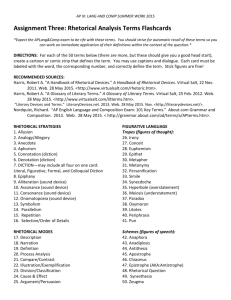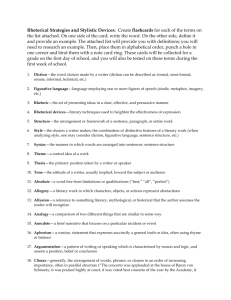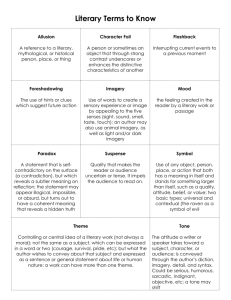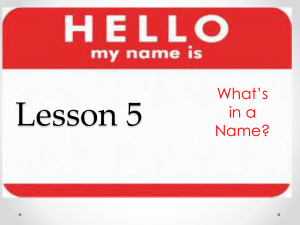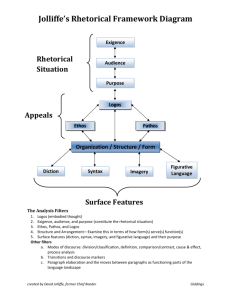AP summer reading assignment
advertisement
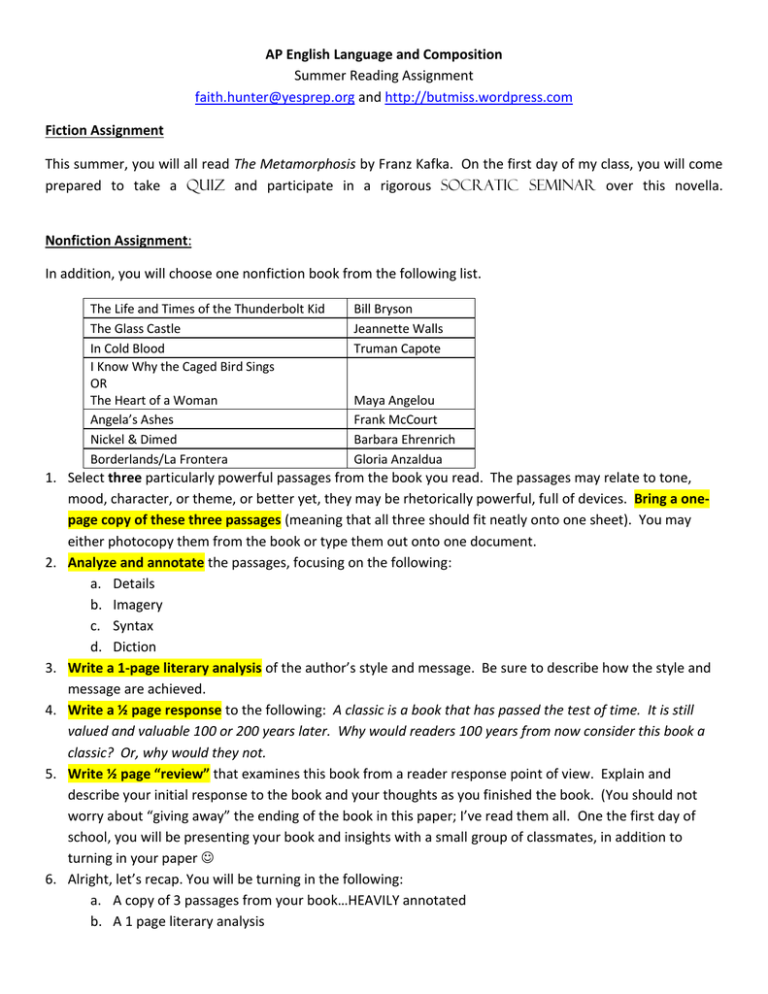
AP English Language and Composition Summer Reading Assignment faith.hunter@yesprep.org and http://butmiss.wordpress.com Fiction Assignment This summer, you will all read The Metamorphosis by Franz Kafka. On the first day of my class, you will come prepared to take a quiz and participate in a rigorous Socratic seminar over this novella. Nonfiction Assignment: In addition, you will choose one nonfiction book from the following list. The Life and Times of the Thunderbolt Kid The Glass Castle In Cold Blood I Know Why the Caged Bird Sings OR The Heart of a Woman Angela’s Ashes Nickel & Dimed Borderlands/La Frontera Bill Bryson Jeannette Walls Truman Capote Maya Angelou Frank McCourt Barbara Ehrenrich Gloria Anzaldua 1. Select three particularly powerful passages from the book you read. The passages may relate to tone, mood, character, or theme, or better yet, they may be rhetorically powerful, full of devices. Bring a onepage copy of these three passages (meaning that all three should fit neatly onto one sheet). You may either photocopy them from the book or type them out onto one document. 2. Analyze and annotate the passages, focusing on the following: a. Details b. Imagery c. Syntax d. Diction 3. Write a 1-page literary analysis of the author’s style and message. Be sure to describe how the style and message are achieved. 4. Write a ½ page response to the following: A classic is a book that has passed the test of time. It is still valued and valuable 100 or 200 years later. Why would readers 100 years from now consider this book a classic? Or, why would they not. 5. Write ½ page “review” that examines this book from a reader response point of view. Explain and describe your initial response to the book and your thoughts as you finished the book. (You should not worry about “giving away” the ending of the book in this paper; I’ve read them all. One the first day of school, you will be presenting your book and insights with a small group of classmates, in addition to turning in your paper 6. Alright, let’s recap. You will be turning in the following: a. A copy of 3 passages from your book…HEAVILY annotated b. A 1 page literary analysis c. A ½ page response to questions about what makes a classic d. A ½ page review of the book ALL of the material must be typed, MLA format, 12 pt font, double-spaced. NO exceptions! AP Flashcards Assignment First of all, you’ll need about 120 note cards for this assignment, and either a note-card box or metal ring for linking them together. Create flashcards for ALL of the terms listed below. This is VITAL for success in the AP English Language course. You’ll be referring to these cards throughout the year. PS. This is NOT a suggestion. BASIC TERMS 1. Diction—the word choices made by a writer (diction can be described as: formal, semi-formal, ornate, informal, technical, etc.) 2. Figurative language—language employing one or more figures of speech (simile, metaphor, imagery, etc.) 3. Rhetoric—the art of presenting ideas in a clear, effective, and persuasive manner 4. Rhetorical devices—literary techniques used to heighten the effectiveness of expression 5. Rhetorical pattern—format or structure followed by a writer such as comparison/contrast or process analysis. 6. Structure—the arrangement or framework of a sentence, paragraph, or entire work 7. Style—the choices a writer makes; the combination of distinctive features of a literary work (when analyzing style, one may consider diction, figurative language, sentence structure, etc.) 8. Syntax—the manner in which words are arranged into sentences 9. Theme—a central idea of a work 10. Thesis—the primary position taken by a writer or speaker 11. Tone—the attitude of a writer, usually implied, toward the subject or audience RHETORICAL & STYLISTIC DEVICES 1. Absolute—a word free from limitations or qualifications (“best,” “all”, “unique,” “perfect”) 2. Ad hominem argument—an argument attacking an individual’s character rather than his or her position on an issue 3. Allegory—a literary work in which characters, objects, or actions represent abstractions 4. Allusion—a reference to something literary, mythological, or historical that the author assumes the reader will recognize 5. Analogy—a comparison of two different things that are similar in some way 6. Anaphora—repetition of the same word or group of words at the beginning of successive clauses (Richard D. Bury: “In books I find the dead as if they were alive; in books I foresee things to come; in books warlike affairs are set forth; from books come forth the laws of peace.”) 7. Anecdote—a brief narrative that focuses on a particular incident or event 8. Anthypophora-- A figure of reasoning in which one asks and then immediately answers one's own rhetorical questions (or raises and then settles imaginary objections). Reasoning aloud. 9. Antithesis—a statement in which two opposing ideas are balanced 10. Aphorism—a concise, statement that expresses succinctly a general truth or idea, often using rhyme or balance 11. Argumentation—a pattern of writing or speaking which is characterized by reason and logic, and asserts a position, belief or conclusion 12. Assonance-- Repetition of similar vowel sounds, preceded and followed by different consonants, in the stressed syllables of adjacent words. Ex: The sergeant asked him to bomb the lawn with hotpots. 13. Asyndeton—a construction in which elements are presented in a series without conjunctions (“They spent the day wondering, searching, thinking, understanding.”) 14. Balanced sentence—a sentence in which words, phrases, or clauses are set off against each other to emphasize a contrast (George Orwell: “If thought corrupts language, language can also corrupt thought.”) 15. Cause/Effect—a pattern of writing or speaking which is characterized by its analysis of why something happens, in contrast to Process, which describes how something happens. Often links situations and events in time, with causes preceding events. Ex: the cause of a war and its effects on a national economy 16. Chiasmus—a statement consisting of two parallel parts in which the second part is structurally reversed (“Susan walked in, and out rushed Mary.”) 17. Classification/Division—a pattern of writing or speaking which is characterized by division, which is the process of breaking a whole into parts, and classification, which is the often subsequent process of sorting individual items into categories. 18. Climax—generally, the arrangement of words, phrases, or clauses in an order of increasing importance, often in parallel structure (“The concerto was applauded at the house of Baron von Schnooty, it was praised highly at court, it was voted best concerto of the year by the Academy, it was considered by Mozart the highlight of his career, and it has become known today as the best concerto in the world.”) 19. Colloquialism—informal words or expressions not usually acceptable in formal writing 20. Comparison/Contrast—a pattern of writing or speaking which is characterized by, in its narrowest sense, how two or more things are similar (compare) and/or how two or more things are different (contrast). 21. Complex sentence—a sentence with one independent clause and at least one dependent clause 22. Compound sentence—a sentence with two or more coordinate independent clauses, often joined by one or more conjunctions 23. Compound-complex sentence—a sentence with two or more principal clauses and one or more subordinate clauses 24. Conceit—a fanciful, particularly clever extended metaphor (Shakespeare’s Sonnet 130 and John Donne’s “A Valediction: Forbidding Mourning” are examples) 25. Concrete details—details that relate to or describe actual, specific things or events 26. Connotation—the implied or associative meaning of a word (slender vs. skinny; cheap vs. thrifty) 27. Cumulative sentence (loose sentence)—a sentence in which the main independent clause is elaborated by the successive addition of modifying clauses or phrases (Jonathan Swift, A Modest Proposal: “I have been assured by a very knowing American friend of my acquaintance in London, that a young healthy child well nursed is at a year old a most delicious, nourishing, and wholesome food, whether stewed, roasted, baked or boiled; and I make no doubt that it will equally serve in a fricassee or a ragout.”) 28. Declarative sentence—a sentence that makes a statement or declaration 29. Deductive reasoning—reasoning in which a conclusion is reached by stating a general principle and then applying that principle to a specific case (The sun rises every morning; therefore, the sun will rise on Tuesday morning.) 30. Definition—a pattern of writing or speaking which strives to inform the audience on what a term means and how it is different from other terms in its class. 31. Denotation—the literal meaning of a word 32. Description—a pattern of writing or speaking which is characterized by physical descriptions of a person, place or thing. It is a pattern that relies on the five senses to inform it. 33. Dialect—a variety of speech characterized by its own particular grammar or pronunciation, often associated with a particular geographical region (“Y’all” = Southern dialect) 34. Didactic statement—having the primary purpose of teaching or instructing 35. Dissonance—harsh, inharmonious, or discordant sounds 36. Ellipsis—the omission of a word or phrase which is grammatically necessary but can be deduced from the context (“Some people prefer cats; others, dogs.”) 37. Epigram—a brief, pithy, and often paradoxical saying 38. Epigraph—a saying or statement on the title page of a work, or used as a heading of a chapter or other section of a work 39. Ethos—the persuasive appeal of one’s character, or credibility 40. Euphemism—an indirect, less offensive way of saying something that is considered unpleasant 41. Exclamatory sentence—a sentence expressing strong feeling, usually punctuated with an exclamation mark 42. Exemplification—a pattern of writing or speaking which is characterized by using one or more particular cases, or examples, to illustrate or explain a general point or an abstract concept. 43. Hyperbole—intentional exaggeration to create an effect 44. Idiom—an expression in a given language that cannot be understood from the literal meaning of the words in the expression; or, a regional speech or dialect (“fly on the wall”, “cut to the chase”, etc.) 45. Imagery—the use of figures of speech to create vivid images that appeal to one of the senses 46. Imperative sentence—a sentence that gives a command 47. Implication—a suggestion an author or speaker makes (implies) without stating it directly. NOTE: the author/speaker implies; the reader/audience infers. 48. Inductive reasoning—deriving general principles from particular facts or instances (“Every cat I have ever seen has four legs; cats are four-legged animals.) 49. Inference—a conclusion on draws (infers) based on premises or evidence 50. Interrogative sentence—a sentence that asks a question 51. Invective—an intensely vehement, highly emotional verbal attack 52. Inverted syntax—a sentence constructed so that the predicate comes before the subject (ex: In the woods I am walking.) 53. Irony—the use of words to convey the opposite of their literal meaning; or, incongruity between what is expected and what actually occurs (situational, verbal, dramatic) 54. Jargon—the specialized language or vocabulary of a particular group or profession 55. Juxtaposition—placing two elements side by side to present a comparison or contrast 56. Litotes—a type of understatement in which an idea is expressed by negating its opposite (describing a particularly horrific scene by saying, “It was not a pretty picture.”) 57. Logos—appeal to reason or logic 58. Malapropism—the mistaken substitution of one word for another word that sounds similar (“The doctor wrote a subscription.”) 59. Maxim—a concise statement, often offering advice; an adage 60. Metaphor—a direct comparison of two different things 61. Metonymy—substituting the name of one object for another object closely associated with it (“The pen [writing] is mightier than the sword [war/fighting].) 62. Mood—the emotional atmosphere of a work 63. Motif—a standard theme, element, or dramatic situation that recurs in various works 64. Narration—is a dominant pattern of writing or speaking which strives to tell a story by presenting events in an orderly, logical sequence. Conventionally utilizes the first or third person perspective. 65. Non sequitur—an inference that does not follow logically from the premises (literally, “does not follow”) 66. Paradox—an apparently contradictory statement that actually contains some truth (“Whoever loses his life, shall find it.”) 67. Parallelism—the use of corresponding grammatical or syntactical forms 68. Parody—a humorous imitation of a serious work (Weird Al Yankovich’s songs, and the Scary Movie series are examples) 69. Parenthetical Comment—a comment that interrupts the immediate subject, often to quality or explain 70. Pathos—the quality in a work that prompts the reader to feel pity 71. Pedantic—often used to describe a writing style, characterized by an excessive display of learning or scholarship, characterized by being narrowly, stodgily, and often ostentatiously learned 72. Personification—endowing non-human objects or creatures with human qualities or characteristics 73. Philippic—a strong verbal denunciation. The term comes from the orations of Demosthenes against Philip of Macedonia in the fourth century. 74. Polysyndeton—the use, for rhetorical effect, of more conjunctions than is necessary or natural (John Henry Newman: “And to set forth the right standard, and to train according to it, and to help forward all students towards it according to their various capacities, this I conceive to be the business of a University.”) 75. Process—(a.k.a., Process Analysis) a pattern of writing or speaking which is characterized by its explanation of how to do something or how something occurs. It presents a sequence of steps and shows how those steps lead to a particular result. (Can be seen often in recipes or instructional manuals, a discussion of steps) 76. Rhetorical question—a question asked merely for rhetorical effect and not requiring an answer 77. Sarcasm—harsh, cutting language or tone intended to ridicule 78. Satire—the use of humor to emphasize human weaknesses or imperfections in social institutions (Jonathan Swift’s Gulliver’s Travels, The Simpsons, etc.) 79. Scheme—an artful deviation from the ordinary arrangement of words (anaphora, anastrophe, antithesis are some examples of schemes) 80. Sibilance--having, containing, or producing the sound of or a sound resembling that of the s or the sh in sash. "And the silken sad uncertain rustling of each purple curtain." 81. Simile—a comparison of two things using “like,” “as,” or other specifically comparative words 82. Simple sentence—a sentence consisting of one independent clause and no dependent clause 83. Solecism—non standard grammatical usage; a violation of grammatical rules (ex: unflammable; they was) 84. Stream of Consciousness—a technique characterized by the continuous unedited flow of conscious experience through the mind recorded on paper. Often used in “interior monologue,” when the reader is privy to a character or narrator’s thoughts. 85. Syllepsis—a construction in which one word is used in two different senses (“After he threw the ball, he threw a fit.”) 86. Syllogism—a three-part deductive argument in which a conclusion is based on a major premise and a minor premise (“All men are mortal; Socrates is a man; therefore, Socrates is mortal.”) 87. Synecdoche—using one part of an object to represent the entire object (for example, referring to a car simply as “wheels”) 88. Synesthesia (or synaesthesia)—describing one kind of sensation in terms of another (“a loud color,” “a sweet sound”) 89. Tautology—needless repetition which adds no meaning or understanding (“Widow woman”, “free gift”) 90. Trope—an artful deviation from the ordinary or principal signification of a word (hyberbole, metaphor, and personification are some examples of tropes) 91. Understatement—the deliberate representation of something as lesser in magnitude than it 92. Vernacular—the everyday speech of a particular country or region, often involving nonstandard usage A few words about the analysis of rhetorical devices: DETAILS The German architect Mies van der Rohe once said, “God dwells in the details.” Another somebody once said in order to pass off a lie, it needs one good detail. Indeed, they are what make stories vivid and real for the reader. Think critically about the details your author chose to include in the passages you chose: what does that detail add? Maybe it’s reader empathy, maybe it’s humor, maybe it’s believability. You figure it out and comment coherently on the effect. IMAGERY Imagery gets the reader’s senses and imagination involved in the process. Often, imagery involves the visual sense, but it can extend to the other four senses, as well. In your career as English students, you’ve learned many tools of imagery: simile, metaphor, alliteration, personification, symbolism. You should include an analysis of imagery in your paper. SYNTAX Syntax is concerned with the structure and pattern of sentences. Repetition, juxtaposition, inverted order, parallelism, polysyndeton, asyndeton, loose and periodic sentences (look ‘em up!) are all syntactical devices that make a difference in how a reader understands the author’s meaning. Punctuation makes a difference. (Take a look at the first three paragraphs of Poe’s Tell-tale Heart. Just the hyperactive dashes alone signal to the reader that the narrator is a crazy person.) The authors of all these books are masters of syntax, so you will find many significant observations to make about their use of it. DICTION I will tell you this a million times in class next year, but we never refer to an author’s diction unless we have an adjective in front of the word diction. Saying, “the author uses a lot of diction” is the same as saying, “the author uses a lot of words.” A tiny sampling of ways to categorize diction includes formal, informal, colloquial, slang, concrete, abstract, denotative, connotative, euphonious, cacophonous; and like I said, that’s a tiny sampling. Once you determine a way to describe the diction, you must then ask (and answer) why the author made such word choices. For more clarity on any of these topics, you can Google “DIDLS,” which is an acronym for details-imagery-diction-language-syntax. Plenty of English nerds have written good stuff on rhetorical analysis, and it’s out there. The expectation is that these assignments will be a challenge to you; however, I will be available to help talk you through the tough spots AFTER you’ve made a valiant effort on your own. In mid July, we will have a “book club” meeting (details later). Feel free to email me or comment on the blog with questions. Faith.Hunter@yesprep.org or http://butmiss.wordpress.com


